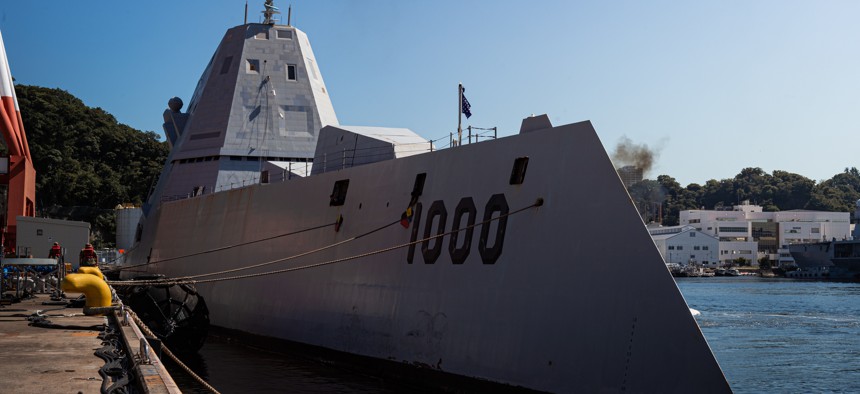
The guided-missile destroyer USS Zumwalt (DDG 1000) arrives at Commander, Fleet Activities Yokosuka (CFAY) for a scheduled port visit. Zumwalt is currently operating in the U.S. 7th Fleet area of operations. U.S Navy photo by Seaman Darren Cordoviz
More than Half of the Pentagon’s Major Arms Efforts Are Late, GAO Finds
The watchdog urges the military to better follow commercial practices.
The Pentagon’s uneven adoption of commercial practices is among the reasons more than half of its major acquisition programs are late, according to a new report by the Government Accountability Office.
Those delays are affecting a wide variety of key weapons such as the Air Force’s Sentinel intercontinental ballistic missile and the Navy’s Zumwalt destroyer, programs that are part of efforts to deter large, high-tech adversaries.
But it’s not all bad news. GAO praised some programs, including some that use the Middle Tier of Acquisition pathway, for using “certain product development practices aligned with key product development principles employed by leading companies.”
Those principles include things like:
- Defining project goals before allocating funding by establishing performance tenets beforehand.
- Using modern design tools like 3-D printing and virtual twinning to make custom parts and prototypes faster
- Dropping over-ambitious capability goals to get a minimal viable product earlier
- Incorporating operators’ feedback as weapons are being designed rather than saddling them with products that don’t meet their needs.
GAO singled out some success stories, such as the Army’s Long-Range Hypersonic Weapon System, which cut development time by using 3-D printing and iterative design—essentially, continuing to design and redesign a product rather than declare it “finished.” And the Army’s Extended Range Cannon Artillery program “reported that it obtained end-user feedback through soldier touchpoints, surveys, written reports, and interviews. According to the program, this feedback has informed design upgrades, new features, and changes to make the system more effective.”
But GAO’s annual report on major weapons is also full of examples of programs that are not following the principles. One example is the Navy’s DDG 1000 Zumwalt guided-missile destroyer, which is to complete operational testing in December, a year later than GAO expected last year. A big part of the reason is that the Navy decided to add to its wishlist for the destroyer rather than subtract. It’s trying to integrate an experimental hypersonic missile onto the ship.
“If the hypersonic weapon is not ready for integration on the DDG 1000 at the time of the aforementioned maintenance period, the Navy may have to extend the duration of the planned maintenance period or wait for the next scheduled period to incorporate the system on the ship,” the report said.
But as the Pentagon becomes more ambitious in its technology wants and needs, there is also a chance for delays even in programs that are implementing the principles. For instance, the report applauds the Army’s IVAS program—which seeks to give soldiers an augmented-reality headset for training and more advanced targeting—for continually seeking feedback from operators to improve its relevance and ease of use. But the program, beset by hardware and software problems and originally scheduled for September 2021, is now slated to arrive in 2024.
Bottom line: the Defense Department pays a lot of lip service to things like modular open architectures, iterative design, and soldier feedback. But it’s not following its own advice as often as it should. Even when it is, innovation is an imperfect process fraught with moments of failure. The Pentagon has to both increase its tolerance for experimental failure without letting failures drive up costs and delays.




